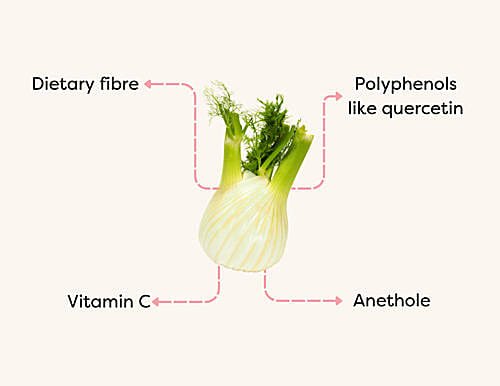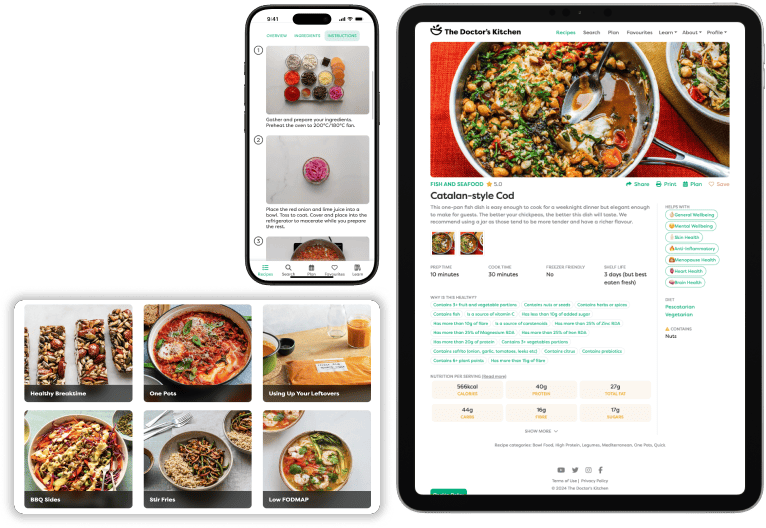Fennel: Pain relief powerhouse
28th Jun 2024
Whether you're slicing it for salads, simmering it slowly or using the seeds, fennel brings a range of nutrients and beneficial plant compounds that could lower inflammation, pain and menopause symptoms.
Key points
Health Benefits
Fennel is a source of:
- Dietary fibre ~3.1g per 100g
- Key nutrients, such as calcium, potassium, phosphorus and vitamin C.
- Polyphenols, such as quercetin, caffeic acid and gallic acid.
- Anethole, which is the main compound in the essential oil. It shows anti-inflammatory and estrogenic effects.

In human trials, fennel extract was associated with improved:
- Menopausal symptoms: Taking fennel extract helped improve symptoms like hot flashes and sleep issues in menopausal women, according to two reviews of clinical trials.
- Menstrual pain: In patients with painful menstruation, fennel extract effectively reduced pain intensity, and cinnamon shortened pain duration, as shown in a meta-analysis of nine randomised controlled trials.
- Joint pain: In a small trial of 66 patients with knee osteoarthritis, fennel extract improved knee pain intensity more than placebo.
The research is ongoing: The studies used fennel extract in capsules with small sample sizes and methodological concerns, so we’re still not sure how it applies to eating whole fennel.
Plant Tales
From Rome to royalty: Native to the southern Mediterranean, fennel has a storied past. Emperor Charlemagne esteemed it so greatly that he mandated its cultivation on all imperial farms. By the 13th century in England, it held royal status as a spice, served to kings alongside fruit, bread, and pickled fish.
Spice, herb or vegetable? Fennel is actually all three! The bulbous base can be eaten as a vegetable, the feathery fronds are used as an herb, and the aromatic seeds are used as a spice and to produce essential oils. Fennel is part of the Apiaceae family, which also includes cumin, dill, carrot, celery, and anise.
Why does it taste like anise? They both share the aromatic compound ‘anethole’, which gives them their distinct flavour and may even offer anti-cancer benefits.
Traditional uses: Around the world, it has a long history of use in traditional medicine for digestive, endocrine and respiratory health. Herbal practitioners use it to promote menstruation and relieve digestive discomfort, such as nausea, low appetite and pain. In India, the seeds are often chewed as mukhwas after meals to promote digestion and freshen the mouth.
5 ways to enjoy
- Crunchy salad like Sicilian fennel-orange salad.
- Soups & stews like the Provençal fish soup Bouillabaisse.
- Buttery side dish, roasted with garlic, herbs, salt, pepper, and olive oil.
- Slaw with apples, red onion, and red cabbage.
- Digestion tea like Indian Saunf Wali Chai.
Recipes
- New Potato and Asparagus Salad with Ranch Dressing
- Charred Leek and Fennel Broth with Haricot Beans (App)
- Green Fisherman’s Stew (App)
Sources
Menopause: Lee et al. 2021 | Khadivzadeh et al. 2018
Menstrual pain: Xu et al. 2020
Joint pain: Alazadeh et al. 2020
- Access over 800 research backed recipes
- Personalise food for your unique health needs

Relevant recipes
-
Pastes, Marinades & Sauces 4.8
Pulled Aubergine Ragu with Lentils and Walnuts
-
Curries 4.6
Classic Chickpea Curry
-
Curries 5.0
Classic Indian Yellow Daal
-
Free!Budget Friendly 4.6
Curried Red Lentils
-
Free!Budget Friendly 4.8
Dr Rupy's Midweek Risotto
-
Free!Pasta 4.3
Spinach, Pea and Broad Bean Pasta with Fennel and Pistachio
-
Casseroles 4.5
Cod and Chickpea Stew
-
Free!Budget Friendly 4.9
Sweet Potato & Parsnip Frittata
-
Tray Bakes 4.9
Pumpkin, Kale and Halloumi Traybake
-
Brunch 4.3
Green Shakshuka
Related articles
-
Food Benefits
Cranberries
-
Food Benefits
Bread: How to choose quality loaves
-
Food Benefits
Mushrooms: Vitamin D & immune support
-
Food Benefits
Pumpkin: Rich in carotenoids for eye health & cancer prevention
-
Food Benefits
Coffee: How to make a healthy cup
-
Food Benefits
Olives: Healthy or too salty?
-
Food Benefits
Olive Oil: Getting the most health benefits
-
Food Benefits
Vinegar for blood sugar, cholesterol & weight loss?
-
Food Benefits
Parsley: Up your plant points